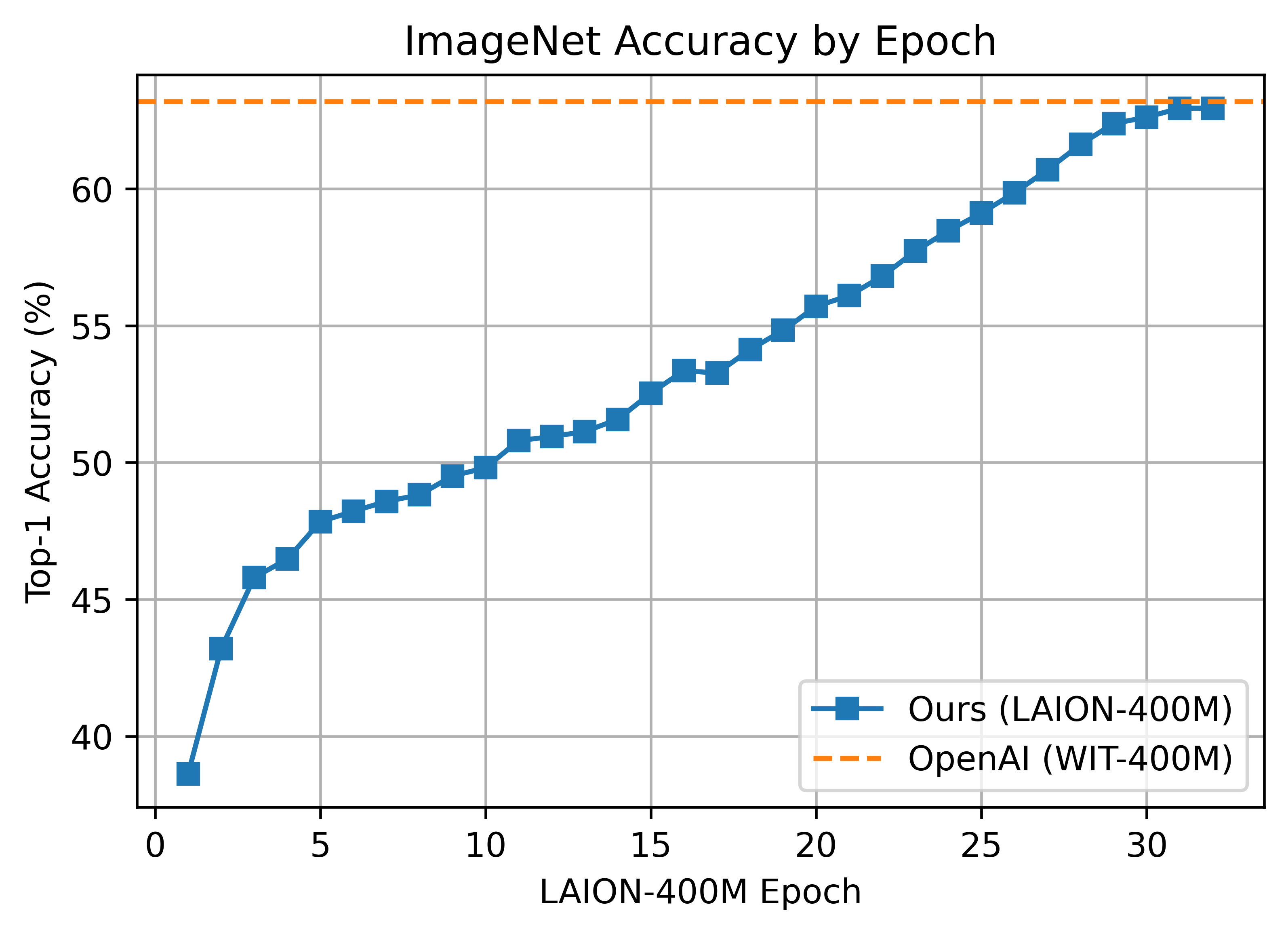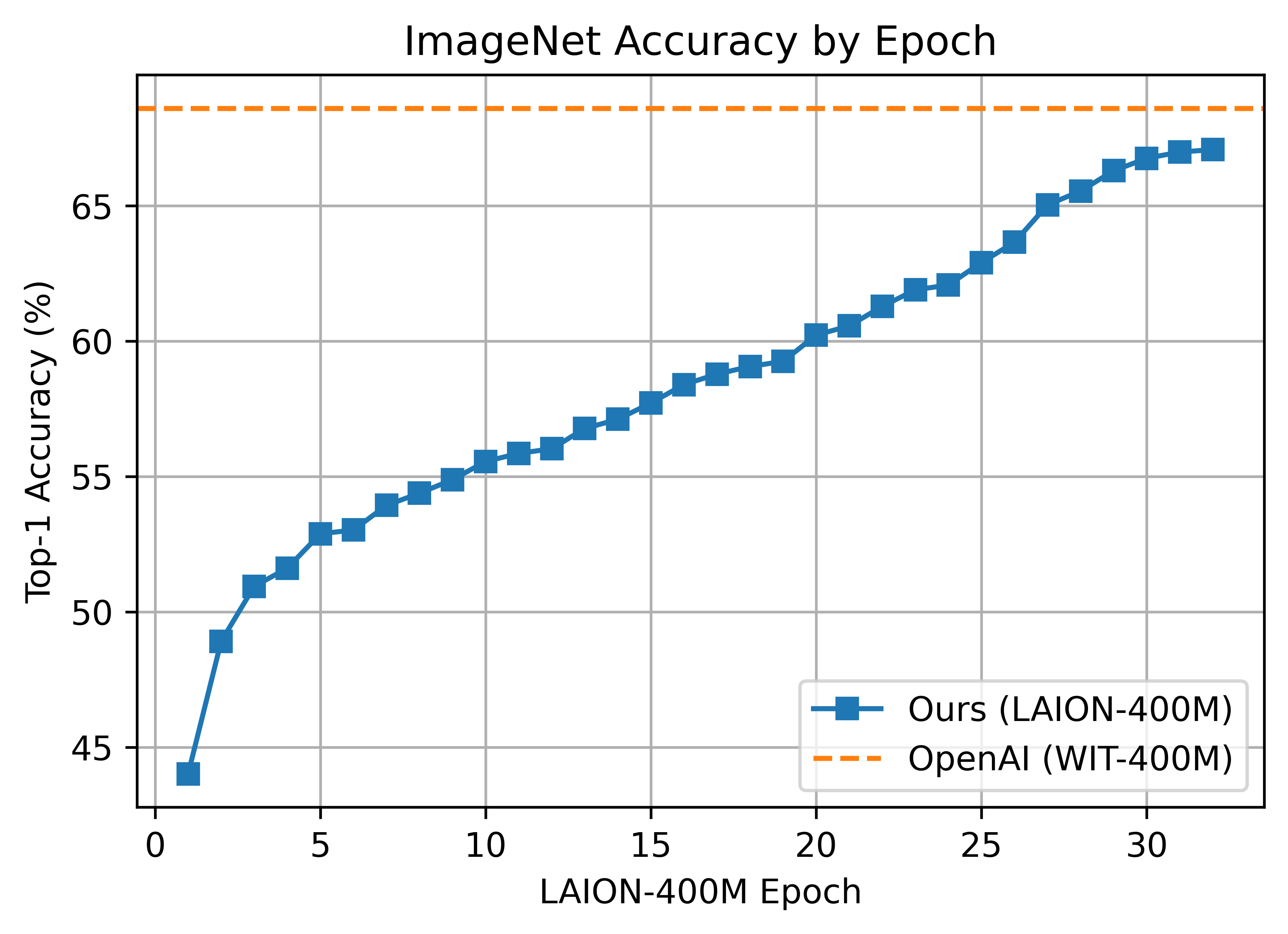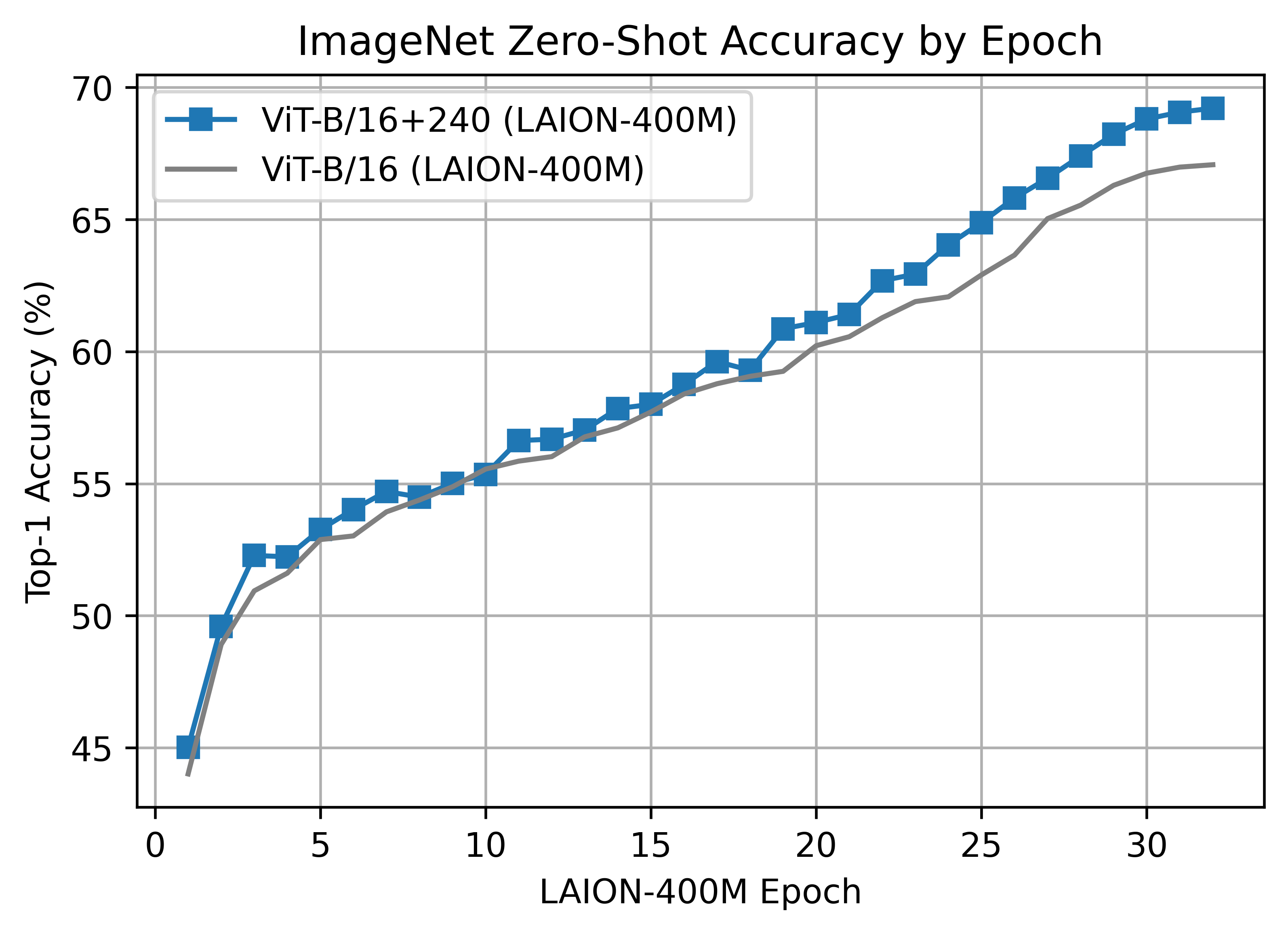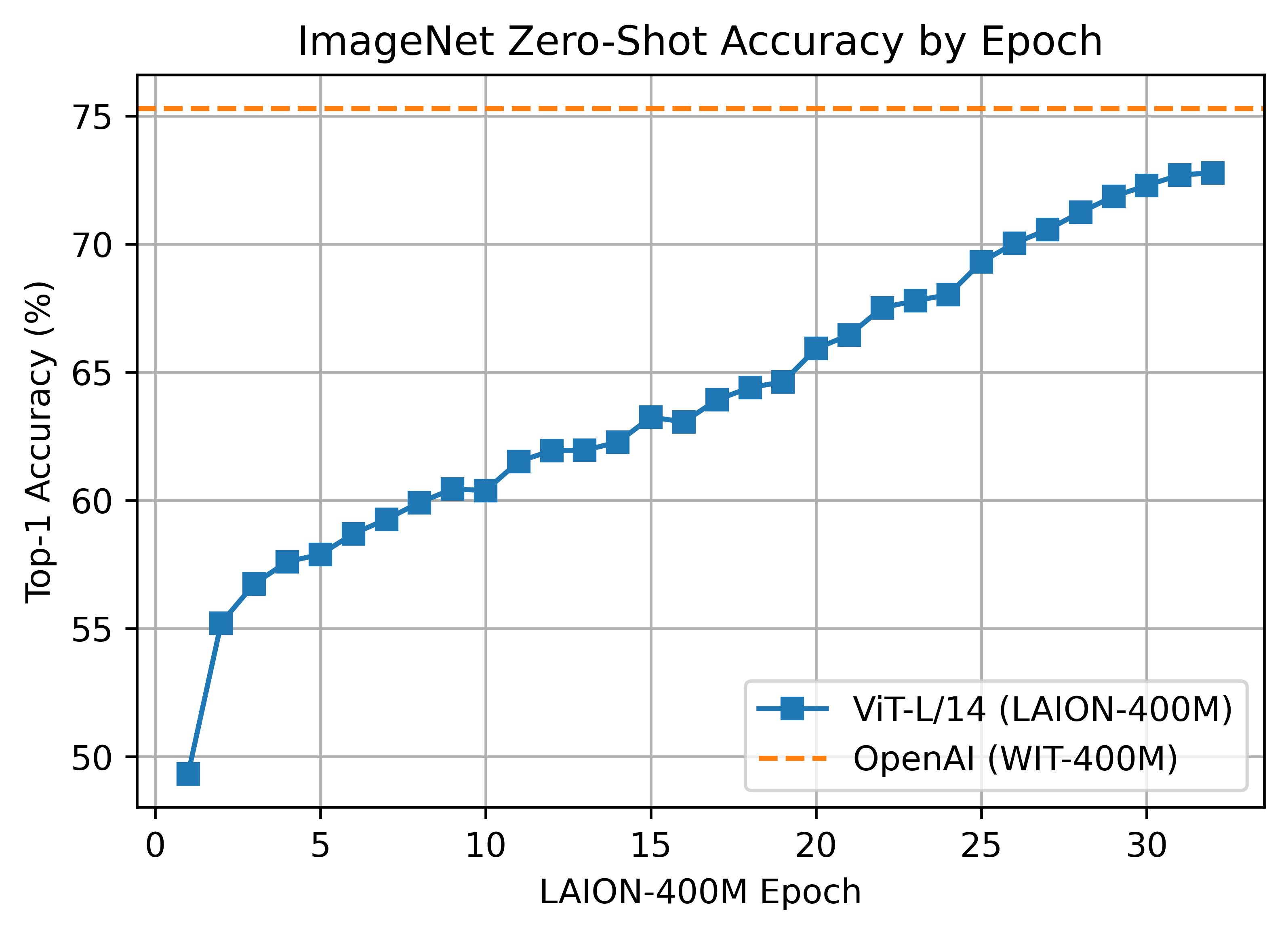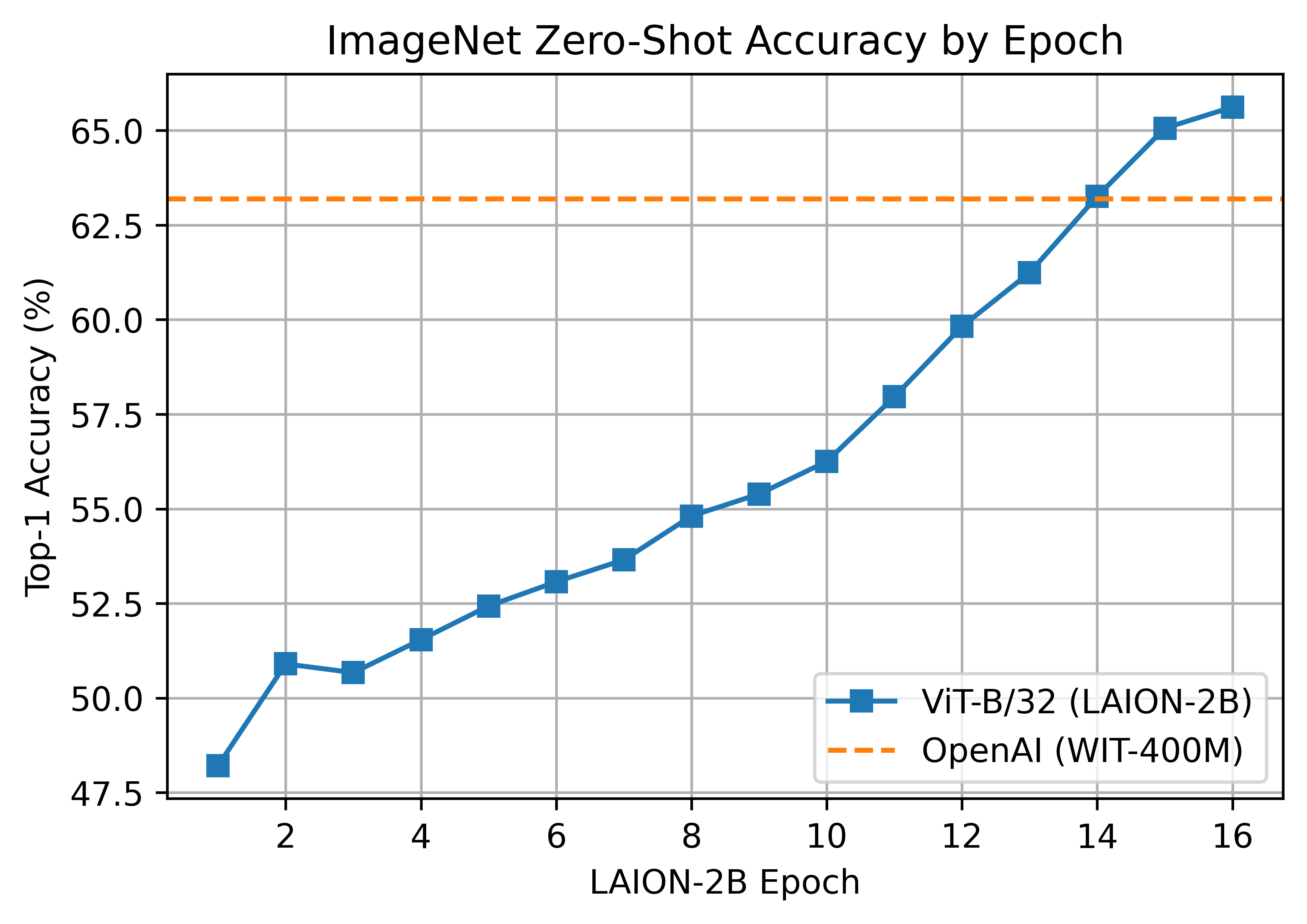We evaluate the full collection of available models on a suite of 38 datasets in a zero-shot setting (i.e., without fine-tuning), following Gadre et al., 2023. Click below to see the full results.
Below are details for several of our pretrained models.
LAION-400M - https://laion.ai/laion-400-open-dataset
We ran experiments in an attempt to reproduce OpenAI's ViT results with the comparably sized (and open) LAION-400M dataset. Trained weights can be found in release v0.2.
The LAION400M weights have been trained on the JUWELS supercomputer (see acknowledgements section below).
We replicate OpenAI's results on ViT-B/32, reaching a top-1 ImageNet-1k zero-shot accuracy of 62.96%.
Zero-shot comparison (courtesy of Andreas Fürst)
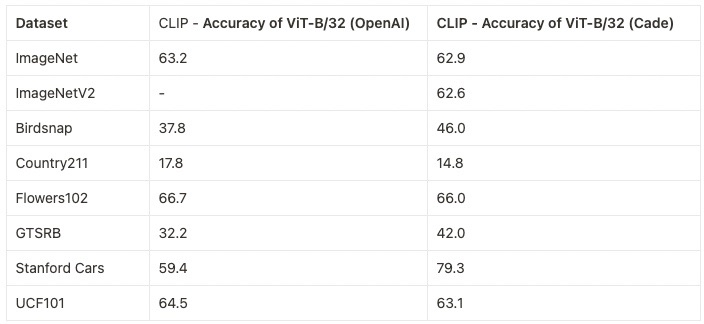
ViT-B/32 was trained with 128 A100 (40 GB) GPUs for ~36 hours, 4600 GPU-hours. The per-GPU batch size was 256 for a global batch size of 32768. 256 is much lower than it could have been (~320-384) due to being sized initially before moving to 'local' contrastive loss.
The B/16 LAION400M training reached a top-1 ImageNet-1k zero-shot validation score of 67.07.
This was the first major train session using the updated webdataset 0.2.x code. A bug was found that prevented shards from being shuffled properly between nodes/workers each epoch. This was fixed part way through training (epoch 26) but likely had an impact.
ViT-B/16 was trained with 176 A100 (40 GB) GPUS for ~61 hours, 10700 GPU-hours. Batch size per GPU was 192 for a global batch size of 33792.
The B/16+ 240x240 LAION400M training reached a top-1 ImageNet-1k zero-shot validation score of 69.21.
This model is the same depth as the B/16, but increases the
- vision width from 768 -> 896
- text width from 512 -> 640
- the resolution 224x224 -> 240x240 (196 -> 225 tokens)
Unlike the B/16 run above, this model was a clean run with no dataset shuffling issues.
ViT-B/16+ was trained with 224 A100 (40 GB) GPUS for ~61 hours, 13620 GPU-hours. Batch size per GPU was 160 for a global batch size of 35840.
The L/14 LAION-400M training reached a top-1 ImageNet-1k zero-shot validation score of 72.77.
ViT-L/14 was trained with 400 A100 (40 GB) GPUS for ~127 hours, 50800 GPU-hours. Batch size per GPU was 96 for a global batch size of 38400. Grad checkpointing was enabled.
A ~2B sample subset of LAION-5B with english captions (https://huggingface.co/datasets/laion/laion2B-en)
A ViT-B/32 trained on LAION-2B, reaching a top-1 ImageNet-1k zero-shot accuracy of 65.62%.
ViT-B/32 was trained with 112 A100 (40 GB) GPUs. The per-GPU batch size was 416 for a global batch size of 46592. Compute generously provided by stability.ai.
A second iteration of B/32 was trained on stability.ai cluster with a larger global batch size and learning rate, hitting 66.6% top-1. See https://huggingface.co/laion/CLIP-ViT-B-32-laion2B-s34B-b79K
A ViT-L/14 with a 75.3% top-1 ImageNet-1k zero-shot was trained on JUWELS Booster. See model details here https://huggingface.co/laion/CLIP-ViT-L-14-laion2B-s32B-b82K
These weights use a different dataset mean and std than others. Instead of using the OpenAI mean & std, inception style normalization [-1, 1] is used via a mean and std of [0.5, 0.5, 0.5]. This is handled automatically if using open_clip.create_model_and_transforms from pretrained weights.
A ViT-H/14 with a 78.0% top-1 ImageNet-1k zero-shot was trained on JUWELS Booster. See model details here https://huggingface.co/laion/CLIP-ViT-H-14-laion2B-s32B-b79K
A ViT-g/14 with a 76.6% top-1 ImageNet-1k zero-shot was trained on JUWELS Booster. See model details here https://huggingface.co/laion/CLIP-ViT-g-14-laion2B-s12B-b42K
This model was trained with a shorted schedule than other LAION-2B models with 12B samples seen instead of 32+B. It matches LAION-400M training in samples seen. Many zero-shot results are lower as a result, but despite this it performs very well in some OOD zero-shot and retrieval tasks.
A ViT-B/32 with roberta base encoder with a 61.7% top-1 ImageNet-1k zero-shot was trained on stability. See model details here https://huggingface.co/laion/CLIP-ViT-B-32-roberta-base-laion2B-s12B-b32k This is the first openclip model using a HF text tower. It has better performance on a range of tasks compared to the standard text encoder, see metrics
A ViT-B/32 with xlm roberta base encoder with a 62.33% top-1 ImageNet-1k zero-shot was trained on stability. See model details here https://huggingface.co/laion/CLIP-ViT-B-32-xlm-roberta-base-laion5B-s13B-b90k This is the first openclip model trained on the full laion5B dataset; hence the first multilingual clip trained with openclip. It has better performance on a range of tasks compared to the standard text encoder, see metrics A preliminary multilingual evaluation was run: 43% on imagenet1k italian (vs 21% for english B/32), 37% for imagenet1k japanese (vs 1% for english B/32 and 50% for B/16 clip japanese). It shows the multilingual property is indeed there as expected. Larger models will get even better performance.
A ViT-H/14 with xlm roberta large encoder with a 77.0% (vs 78% for the english equivalent) top-1 ImageNet-1k zero-shot was trained on stability. See model details here https://huggingface.co/laion/CLIP-ViT-H-14-frozen-xlm-roberta-large-laion5B-s13B-b90k
This model was trained following the LiT methodology: the image tower was frozen (initialized from english openclip ViT-H/14), the text tower was initialized from xlm roberta large and unfrozen. This reduced training cost by a 3x factor.
See full english metrics
On zero shot classification on imagenet with translated prompts this model reaches:
- 56% in italian (vs 21% for https://github.com/clip-italian/clip-italian)
- 53% in japanese (vs 54.6% for https://github.com/rinnakk/japanese-clip)
- 55.7% in chinese (to be compared with https://github.com/OFA-Sys/Chinese-CLIP)
Below are checkpoints of models trained on YFCC-15M, along with their zero-shot top-1 accuracies on ImageNet and ImageNetV2. These models were trained using 8 GPUs and the same hyperparameters described in the "Sample running code" section, with the exception of lr=5e-4 and epochs=32.
- ResNet-50 (32.7% / 27.9%)
- ResNet-101 (34.8% / 30.0%)
- ResNet-50 (36.45%)
As part of DataComp, we trained models on CommonPool using various data filtering strategies.
The best performing models are specified below for the xlarge scale, see our paper DataComp: In seearch of the next generation of multimodal datasets for more details.
Additional models and more information can be found at /docs/datacomp_models.md.
-
datacomp_xl_s13b_b90k: A ViT-L/14 trained on DataComp-1B for 12.8B steps and batch size 90k. Achieves 79.2% zero-shot accuracy on ImageNet. Available at https://huggingface.co/laion/CLIP-ViT-L-14-DataComp.XL-s13B-b90K. -
commonpool_xl_clip_s13b_b90k: A ViT-L/14 trained on CommonPool-XL filtered using CLIP scores, for 12.8B steps and batch size 90k. Achieves 76.4% zero-shot accuracy on ImageNet. Available at https://huggingface.co/laion/CLIP-ViT-L-14-CommonPool.XL.clip-s13B-b90K. -
commonpool_xl_laion_s13b_b90k: A ViT-L/14 trained on CommonPool-XL filtered using the LAION-2B filtering scheme, for 12.8B steps and batch size 90k. Achieves 75.5% zero-shot accuracy on ImageNet. Available at https://huggingface.co/laion/CLIP-ViT-L-14-CommonPool.XL.laion-s13B-b90K. -
commonpool_xl_s13b_b90k: A ViT-L/14 trained on CommonPool-XL without any filtering, for 12.8B steps and batch size 90k. Achieves 72.3% zero-shot accuracy on ImageNet. Available at https://huggingface.co/laion/CLIP-ViT-L-14-CommonPool.XL-s13B-b90K.
MetaCLIP models are described in the paper Demystifying CLIP Data. These models were developed by Hu Xu, Saining Xie, Xiaoqing Ellen Tan, Po-Yao Huang, Russell Howes, Vasu Sharma, Shang-Wen Li, Gargi Ghosh, Luke Zettlemoyer and Christoph Feichtenhofer from Meta, New York University and the University of Washington.
Models and are licensed under CC-BY-NC. More details are available at https://github.com/facebookresearch/MetaCLIP.
If you use MetaCLIP models, please cite the following:
@inproceedings{xu2023metaclip,
title={Demystifying CLIP Data},
author={Hu Xu, Saining Xie, Xiaoqing Ellen Tan, Po-Yao Huang, Russell Howes, Vasu, Sharma, Shang-Wen Li, Gargi Ghosh, Luke Zettlemoyer and Christoph Feichtenhofer},
journal={arXiv preprint arXiv:2309.16671},
year={2023}
}